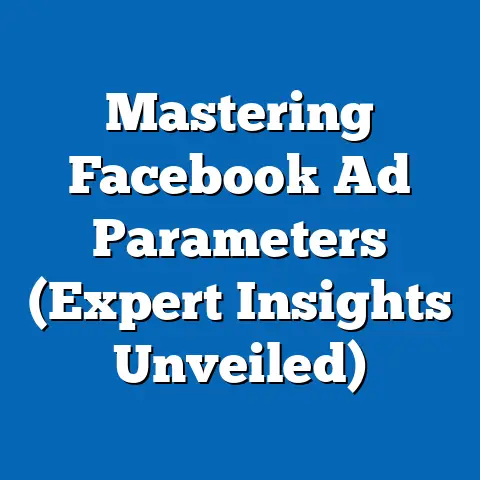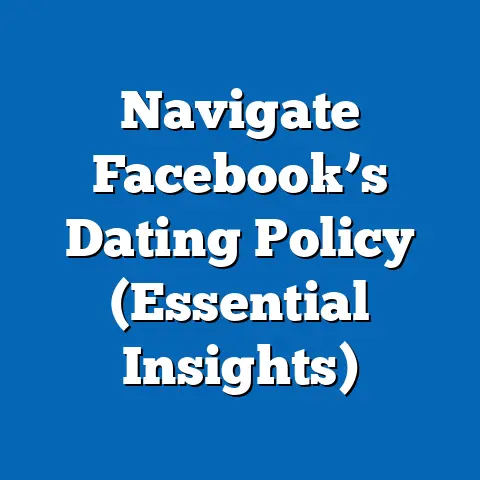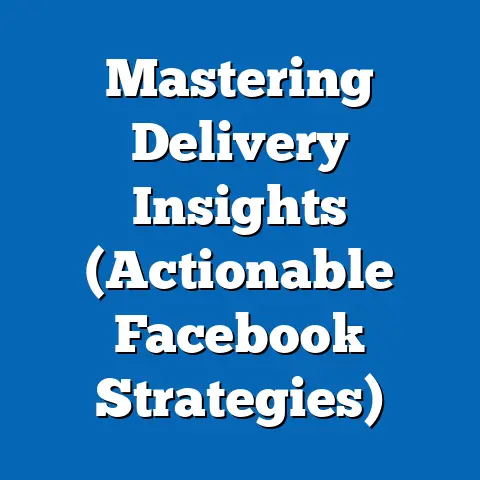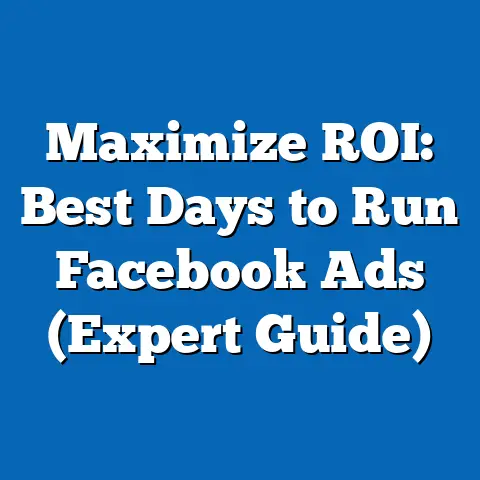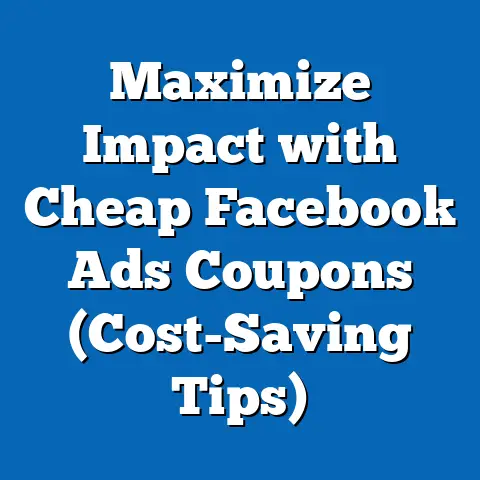Boosting Facebook Ads After a Performance Dip (Pro Secrets)
Remember that feeling? The initial rush when you launched your Facebook ad campaign. The satisfying ping of new likes, the flurry of shares, and the sweet sound of conversions rolling in. I remember one campaign I launched for a local bookstore; it was like a dam had broken. The dashboard was alive, a vibrant testament to a strategy well-executed. But then…silence. The pings faded. The dashboard flatlined. The bookstore owner called, worried. That sinking feeling? I know it well.
It’s a familiar story for many marketers. You pour your heart and soul into crafting the perfect ad, only to see its performance plateau or, even worse, plummet. The good news? A performance dip isn’t a death sentence for your Facebook ads. It’s a signal – a nudge to re-evaluate, refine, and ultimately, revitalize your strategy. Let’s dive into the pro secrets I’ve learned over the years to get your campaigns back on track.
Understanding the Causes of Performance Dips
Before you can fix a problem, you need to understand what caused it. Facebook ad performance dips rarely happen in a vacuum. They’re usually the result of a combination of factors. Let’s break down some of the most common culprits:
- Audience Fatigue: This is the big one. Imagine seeing the same ad, day after day, week after week. Even if it was initially engaging, you’d eventually tune it out, right? That’s audience fatigue. Your target audience gets tired of seeing the same creative, the same messaging, and the same offer. They become “ad blind.” According to a study by Nielsen, ad recall decreases by as much as 50% after just a few weeks of exposure.
- Ad Creative Stagnation: Closely related to audience fatigue, ad creative stagnation occurs when your visuals and copy become stale. Think of it like this: you wouldn’t wear the same outfit every day, would you? Your ads need to evolve to stay relevant and engaging.
- Facebook Algorithm Changes: Ah, the ever-elusive Facebook algorithm. This is the behind-the-scenes magic (or sometimes, black magic) that determines which ads users see. Facebook is constantly tweaking its algorithm to improve user experience, which can have a direct impact on ad performance. For instance, in 2018, Facebook prioritized posts from friends and family over content from brands, leading to significant organic reach declines for many businesses. Algorithm updates can affect ad delivery, targeting accuracy, and overall performance.
- Increased Competition: The Facebook ad landscape is a crowded marketplace. As more businesses compete for the same audience, ad costs can increase, and ad performance can suffer. This is especially true during peak seasons like holidays or major sales events.
- Shifts in Market Trends: Consumer preferences and buying habits are constantly evolving. What worked last year might not work today. You need to stay informed about current trends and adapt your messaging and offers accordingly. I remember when fidget spinners were all the rage. Businesses that jumped on that trend early saw huge success, but those who waited too long missed the boat.
- External Factors: Sometimes, external factors beyond your control can impact ad performance. For example, a major news event, a change in the economy, or even the weather can influence consumer behavior.
My Experience: I once worked with a clothing brand that saw a sudden drop in ad performance during the summer months. After some digging, we realized that their ads were still focused on winter apparel! A simple switch to showcasing their summer collection revitalized their campaign.
Takeaway: Don’t panic when you see a performance dip. Instead, take a step back and analyze the potential causes. Understanding the “why” is the first step toward finding a solution.
Diagnostic Tools and Techniques
Now that you have a better understanding of the potential causes of performance dips, it’s time to put on your detective hat and start digging into the data. Fortunately, Facebook provides a wealth of tools and metrics to help you diagnose the problem.
- Facebook Ads Manager: This is your command center. The Ads Manager allows you to track key performance metrics, analyze campaign performance, and identify areas for improvement. Pay close attention to metrics like:
- Click-Through Rate (CTR): The percentage of people who see your ad and click on it. A low CTR suggests that your ad isn’t resonating with your audience.
- Conversion Rate: The percentage of people who click on your ad and complete a desired action, such as making a purchase or filling out a form. A low conversion rate indicates a problem with your landing page or offer.
- Cost Per Acquisition (CPA): The cost of acquiring a new customer. A high CPA means you’re spending too much money to get results.
- Relevance Score: This metric (which Facebook is phasing out, so keep an eye out for its replacement) measures how relevant your ad is to your target audience. A low relevance score suggests that your targeting is off.
- Frequency: This metric tells you how many times, on average, people are seeing your ad. A high frequency can lead to ad fatigue.
- A/B Testing: Also known as split testing, A/B testing involves creating two versions of your ad (A and B) and showing them to different segments of your audience. This allows you to test different elements of your ad, such as the headline, image, or call-to-action, to see which performs best.
- Ad Audit: A thorough ad audit involves reviewing all of your active and past campaigns to identify patterns and trends. Look for common themes among your best-performing ads and your worst-performing ads. What worked? What didn’t? What can you learn from your mistakes?
- Click-Through Rate (CTR): The percentage of people who see your ad and click on it. A low CTR suggests that your ad isn’t resonating with your audience.
- Conversion Rate: The percentage of people who click on your ad and complete a desired action, such as making a purchase or filling out a form. A low conversion rate indicates a problem with your landing page or offer.
- Cost Per Acquisition (CPA): The cost of acquiring a new customer. A high CPA means you’re spending too much money to get results.
- Relevance Score: This metric (which Facebook is phasing out, so keep an eye out for its replacement) measures how relevant your ad is to your target audience. A low relevance score suggests that your targeting is off.
- Frequency: This metric tells you how many times, on average, people are seeing your ad. A high frequency can lead to ad fatigue.
My Experience: I once inherited a Facebook ad account from another agency. The campaigns were generating a lot of clicks, but very few conversions. After conducting an ad audit, I discovered that the landing page was slow to load and difficult to navigate. Simply optimizing the landing page increased conversions by 50%!
Takeaway: Data is your best friend. Use the tools and metrics available to you to diagnose the root cause of your performance dip. Don’t rely on gut feelings; let the data guide your decisions.
Refreshing Your Ad Creative
As I mentioned earlier, audience fatigue is a major contributor to performance dips. One of the most effective ways to combat audience fatigue is to refresh your ad creative. This means updating your visuals, copy, and offers to keep your ads fresh and engaging.
- Experiment with Different Content Formats: Facebook offers a variety of ad formats, including:
- Image Ads: Simple, visually appealing ads that feature a single image or graphic.
- Video Ads: Engaging ads that use video to tell a story and capture attention.
- Carousel Ads: Ads that allow you to showcase multiple images or videos in a single ad unit.
- Collection Ads: Ads that feature a catalog of products and allow users to browse and purchase directly from the ad.
- Instant Experience Ads: Full-screen, mobile-optimized ads that load instantly and provide an immersive experience.
- Craft Compelling Ad Copy: Your ad copy should be clear, concise, and persuasive. Use strong headlines, highlight the benefits of your product or service, and include a clear call-to-action.
- Use High-Quality Visuals: Your visuals should be eye-catching and relevant to your target audience. Use high-resolution images and videos that are professionally produced.
- Tell a Story: People are more likely to engage with ads that tell a story. Use your ads to connect with your audience on an emotional level and build a relationship.
- Highlight Customer Testimonials: Social proof is a powerful marketing tool. Include customer testimonials in your ads to build trust and credibility.
- Offer a Discount or Promotion: Everyone loves a good deal. Offering a discount or promotion can incentivize people to take action.
- Image Ads: Simple, visually appealing ads that feature a single image or graphic.
- Video Ads: Engaging ads that use video to tell a story and capture attention.
- Carousel Ads: Ads that allow you to showcase multiple images or videos in a single ad unit.
- Collection Ads: Ads that feature a catalog of products and allow users to browse and purchase directly from the ad.
- Instant Experience Ads: Full-screen, mobile-optimized ads that load instantly and provide an immersive experience.
My Experience: I worked with a local restaurant that was struggling to attract new customers. We created a video ad showcasing their delicious food and inviting people to try their new menu. The ad was a huge success, generating a significant increase in foot traffic.
Takeaway: Don’t be afraid to experiment with different ad creatives. The more you test, the better you’ll understand what resonates with your audience.
Reassessing Your Target Audience
Even the most compelling ad creative won’t perform well if it’s not being shown to the right people. That’s why audience targeting is so critical to the success of your Facebook ads. If you’re experiencing a performance dip, it’s time to reassess your target audience and make sure you’re still reaching the right people.
- Review Your Existing Audience Segments: Take a look at your existing audience segments and make sure they’re still relevant. Are you targeting the right demographics? Are you using the right interests and behaviors?
- Identify New Potential Customer Bases: Think outside the box and explore new potential customer bases. Are there any untapped markets that you could be targeting?
- Use Lookalike Audiences: Lookalike audiences allow you to target people who are similar to your existing customers. This is a great way to expand your reach and find new customers who are likely to be interested in your product or service.
- Leverage Retargeting: Retargeting allows you to show ads to people who have previously interacted with your business, such as website visitors or customers who have abandoned their shopping cart.
- Stay Attuned to Demographic Shifts and Behavioral Changes: Consumer preferences and buying habits are constantly evolving. Stay informed about current trends and adapt your targeting accordingly.
My Experience: I worked with an e-commerce company that was targeting a broad audience of “online shoppers.” After analyzing their data, I discovered that their most valuable customers were actually “eco-conscious millennials.” By narrowing their targeting to focus on this specific demographic, we were able to significantly improve their ad performance.
Takeaway: Don’t assume that your initial target audience is the right one. Continuously reassess your audience and refine your targeting to reach the people who are most likely to convert.
Leveraging Retargeting Techniques
Retargeting is one of the most powerful tools in the Facebook advertising arsenal. It allows you to re-engage users who have already shown interest in your business, but haven’t yet converted. Think of it as a second chance to make a first impression.
- Dynamic Ads: Dynamic ads allow you to show users ads for the specific products they viewed on your website. This is a highly effective way to remind them of what they were interested in and encourage them to complete their purchase.
- Sequential Messaging: Sequential messaging involves showing users a series of ads that build on each other over time. This allows you to tell a story and guide users through the customer journey.
- Personalized Offers: Personalized offers are a great way to incentivize users to take action. Offer a discount, free shipping, or other special promotion to users who have previously interacted with your business.
- Segment Retargeting Campaigns Based on User Behavior: Don’t treat all retargeting audiences the same. Segment your campaigns based on user behavior, such as website visits, cart abandonment, or engagement with previous ads.
My Experience: I worked with a travel agency that was struggling to convert website visitors into bookings. We implemented a retargeting campaign that showed users ads for the specific destinations they had viewed on the website. We also offered a discount on their next booking. The retargeting campaign resulted in a 30% increase in bookings.
Takeaway: Retargeting is a powerful tool for re-engaging users and driving conversions. Use it strategically to target users who have already shown interest in your business.
Timing and Frequency Optimization
Timing is everything in advertising. Showing your ads at the right time can significantly improve engagement and conversion rates. Similarly, showing your ads too frequently can lead to ad fatigue and negative brand perception.
- Explore Insights into Audience Behavior: Use Facebook Insights to learn more about your audience’s behavior. When are they most active on Facebook? What types of content do they engage with?
- Leverage Peak Activity Times and Seasonal Trends: Schedule your ads to run during peak activity times and capitalize on seasonal trends. For example, if you’re selling winter apparel, you’ll want to run your ads during the colder months.
- Manage Ad Frequency: Monitor your ad frequency and adjust your targeting or budget to avoid overexposure. A good rule of thumb is to aim for a frequency of 3-5 per week.
- Test Different Scheduling Options: Experiment with different scheduling options to find the optimal times for ad delivery. You can use Facebook’s “dayparting” feature to schedule your ads to run only during certain hours of the day.
My Experience: I worked with a coffee shop that was running ads 24/7. After analyzing their data, I discovered that their ads were most effective during the morning hours. By scheduling their ads to run only between 6 am and 10 am, we were able to significantly improve their ad performance and reduce their ad spend.
Takeaway: Timing and frequency are important factors in ad performance. Pay attention to your audience’s behavior and optimize your scheduling accordingly.
Testing and Iterating on Your Strategy
The Facebook advertising landscape is constantly evolving. What works today might not work tomorrow. That’s why it’s so important to embrace a “test and learn” approach and continuously iterate on your strategy.
- Embrace Experimentation: Don’t be afraid to try new things. Experiment with different ad creatives, targeting options, and bidding strategies.
- Set Up Effective A/B Tests: Use A/B testing to compare different versions of your ads and identify what works best.
- Define Key Performance Indicators (KPIs): Before you start testing, define the KPIs that you’ll use to measure success. This will help you stay focused and avoid getting distracted by irrelevant metrics.
- Analyze Results: Carefully analyze the results of your tests and use the data to inform your decisions.
- Adapt Strategies Based on Real-Time Data and Market Feedback: Be agile and adapt your strategies based on real-time data and market feedback.
My Experience: I worked with a software company that was launching a new product. We ran several A/B tests to determine the best messaging and targeting for their ads. One of our tests revealed that targeting “early adopters” resulted in a significantly higher conversion rate than targeting a broader audience. We then focused our campaign on early adopters, which led to a successful product launch.
Takeaway: The key to success in Facebook advertising is continuous testing and iteration. Embrace experimentation, analyze your results, and adapt your strategies accordingly.
Conclusion
A performance dip in your Facebook ads can be frustrating, but it’s not the end of the world. By understanding the causes of performance dips, utilizing diagnostic tools and techniques, and implementing the strategies I’ve shared in this article, you can revitalize your campaigns and get back on track.
Remember, every setback is an opportunity for growth and innovation. Embrace the challenge, learn from your mistakes, and never stop testing and iterating. Take the insights and strategies I’ve shared in this article to heart, and you’ll be well on your way to achieving your Facebook advertising goals.
So, go forth and conquer! Analyze your data, refresh your creative, reassess your audience, leverage retargeting, optimize your timing and frequency, and never stop testing. I know you can do it! Now, go watch those campaigns flourish.

